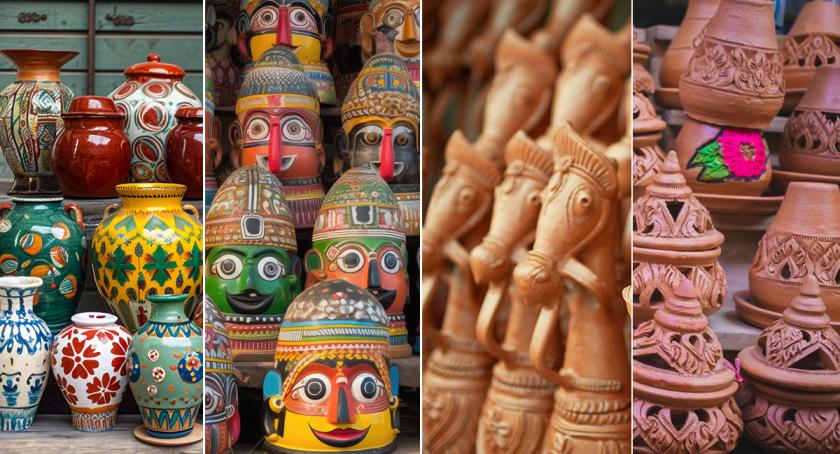Odisha Clay Tales of Terracotta
Odisha, a land steeped in culture, history, and artistic heritage, has long been renowned for its diverse art forms. Among its many treasures, the terracotta craft of Odisha stands out as long-lasting evidence of the state’s rich artistic lineage. This complex and soulful art, molded from humble clay, tells stories of mythology, folklore, and the daily lives of the people of Odisha. Let us set out on an enchanting journey into the world of Odisha’s terracotta artistry, where the earth meets artistry.
A Heritage of Clay Tracing Odisha’s Terracotta Origins
The history of terracotta in Odisha dates back to ancient times, with archaeological evidence suggesting its presence during the Mauryan and Gupta periods. The state’s indigenous communities, including the potter caste known as ‘Kumbhakar,’ have been instrumental in preserving and propagating this unique craft. Traditionally, artisans created religious idols, household items, and decorative pieces from terracotta to grace temples and homes.
Odisha’s terracotta artistry is deeply intertwined with the Jagannath cult, reflecting the profound spiritual connection between the people and their deities. From tiny clay figurines of Lord Jagannath, Balabhadra, and Subhadra to grand temple structures, the craft embodies devotion and complex craftsmanship.
The Artistic Process Behind Terracotta Masterpieces
Creating a terracotta masterpiece is an elaborate process that demands skill, patience, and an intimate knowledge of the medium. The journey begins with sourcing high-quality clay from riverbeds. Artisans knead the clay to remove impurities and achieve the desired consistency. Depending on the object’s nature, artisans shape the clay using hand-molding, wheel-throwing, or casting techniques.
Artisans achieve the desired form and then intricately carve patterns, motifs, and figurines onto the surface, bringing life to the clay. The pieces are left to dry naturally before being fired in kilns at high temperatures to attain durability. The final step often involves applying natural dyes or coatings to enhance the aesthetic appeal while preserving terracotta’s raw, earthen charm.
Themes and Motifs Celebrating Culture Through Clay Art
Odisha’s terracotta art deeply reflects its cultural ethos, with motifs inspired by nature, mythology, and folklore. Some of the most prevalent themes include:
- Religious Iconography: Terracotta sculptures frequently depict Lord Jagannath, Goddess Durga, and other Hindu deities. They serve as worship objects and decorative pieces.
- Floral and Geometric Patterns: Many terracotta works feature complex designs inspired by temple architecture and nature, lending them a timeless aesthetic.
- Animal and Bird Figurines: Horses, elephants, and owls- often considered symbols of prosperity and protection- are popular subjects in Odisha’s terracotta creations.
- Scenes from Everyday Life: Artisans often capture moments from rural life, from women carrying water pots to farmers tilling their fields, preserving the essence of Odisha’s lifestyle.
Famous Terracotta Hubs Preserving Odisha Craft
Several regions in Odisha are renowned for their exceptional terracotta artistry. Some of the most prominent hubs include:
- Balasore: Known for its finely detailed terracotta panels and figurines, Balasore has been a key center for this craft for centuries.
- Mayurbhanj: The tribal artisans of Mayurbhanj stun with their terracotta animal figures, particularly horses and elephants, revered for their symbolic significance.
- Barpali: This small town in western Odisha is famed for its terracotta votive offerings and temple art.
- Sambalpur: Artisans craft beautiful decorative pieces that showcase traditional Odia motifs and temple architecture.
Terracotta of Odisha: Modern Times and Revival
While terracotta remains an intrinsic part of Odisha’s cultural fabric, the craft has faced challenges due to industrialization and changing consumer preferences. However, a resurgence of interest in handmade, sustainable, and eco-friendly products has breathed new life into this ancient art form.
Today, terracotta from Odisha is finding its way into modern spaces, with designers incorporating it into home decor, jewelry, and architectural elements. The government and various NGOs are also pivotal in promoting terracotta artisans by organizing fairs, exhibitions, and training programs to help them adapt to modern market trends.
Why Terracotta Matters: Supporting a Sustainable Artistic Heritage
Terracotta is more than just an art form- an enduring and eco-friendly alternative to synthetic materials. Unlike plastic and chemically treated decor, terracotta is biodegradable and requires minimal production resources. By supporting terracotta artisans, we keep an ancient craft alive and contribute to sustainable living practices that honor the earth.
A Classic Cultural Treasure
The terracotta art of Odisha celebrates heritage, culture, and artistry. Every piece conveys a tale while retaining the spirit of a long-standing tradition and the warmth of the hands who created it. As we appreciate this art’s beauty, let’s also commit to helping the craftspeople who continue this legacy so that the eternal stories will inspire future generations in clay.


